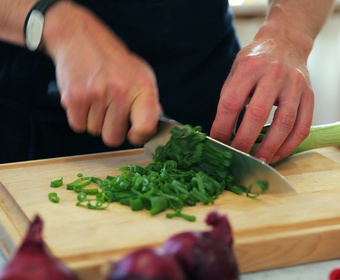All about the cutting board
This basic tool gets less attention than many other kitchen implements. But for a chef, it is no secret that it is one of the tools most used.
The knife and the cutting board are like yin and yang.
– Per Renhed, former chef at The Restaurant, London
The right stability
Stability and steadiness is something to look for in a cutting board – and when cutting. A damp kitchen towel or dishcloth is the perfect foundation to keep your cutting board in its place, making your work a lot easier and safer.
Clean and dry
A chef frequently dries the surface of the board with a clean kitchen towel. A dirty board is washed.
Soft materials...
The materials used for a board should be high quality and of just the right softness. Wood has a unique ability to 'heal' naturally from gashes caused by a knife.
...but not too soft
Bacteria thrive in cracks and scratches. And a sharp blade can sink so deep into the wood that you risk breaking the fine edge.
Wood or plastic
Studies indicate that bacteria dislike wood. But in a professional kitchen plastic boards of different colors are often used to separate raw food, cooked food, fish, greens, and so on.
In your kitchen
Wood and plastic are best for the knife. They are equally hygienic (how you care for the board is more important than the material). Plastic is dishwasher proof, but wood is more attractive – even more so when used a lot.
A tip from the pros:
Use your wooden cutting board for bread, greens and cooked meat. Use plastic boards for fish and raw chicken and machine wash them in 60°C.
Suitable oil
Cooking oils lack the ability to penetrate into the wood and tend to go rancid. Use paraffin oil to prolong the life of your wooden cutting board.
Horizontal or vertical wood
Horizontal wood is not as soft as standing wood, but the boards require less glue. Horizontal wood is less absorbent. You decide what is more attractive.
Appetizing wood
A basic rule for wooden cutting boards is that the material should come from trees producing edible fruits, nuts or sap.
Think decoratively
In a professional environment, a cutting board never leaves the kitchen, but at home you can use your board as an attractive and rustic platter.
Sand like new
The surface of your cutting board will wear. Make it like new again by applying some sandpaper.
Caring for a wooden cutting board
- Avoid letting food and liquids soak into the wood for a long time.
- Do not wash in the dish washer.
- Do not soak. Wash with warm water and detergent. Stand up and leave to dry away from water, the spot behind the faucet might not be the best place.
- Saturate with paraffin oil – which is harmless and tasteless – on a regular basis. Bees wax seals pores in the wood and repels water. If possible, use both.
Other materials
- RUBBER cutting boards are kind to the knife, steady and easy to clean. However, they are unattractive, clumsy and may lose their shape from machine washing.
- BAMBOO has many positive qualities, but joining the small pieces into a board requires large amounts of glue. It is hard on the knife and can be unhealthy, not least for the manufacturer.
- Avoid cutting boards made of GLASS, PORCELAIN, HARD PLASTIC and LAMINATE which will dull your knife. Also, avoid low-quality SOFT PLASTIC.
Over the sink
Lack of space in your kitchen? See if you can place the cutting board steadily over the sink.
Tips and tricks:
- Put a few drops of water on deep scores to make the wood swell shut (also works if you happen to drop your knife point first into the kitchen floor).
- You can disinfect a wood cutting board with vinegar. Or scrub it with salt and a kitchen scrub brush and let soak for 30 minutes.
- Saturate the board with paraffin oil if it looks dry, has light stains, or after cleaning as above.



